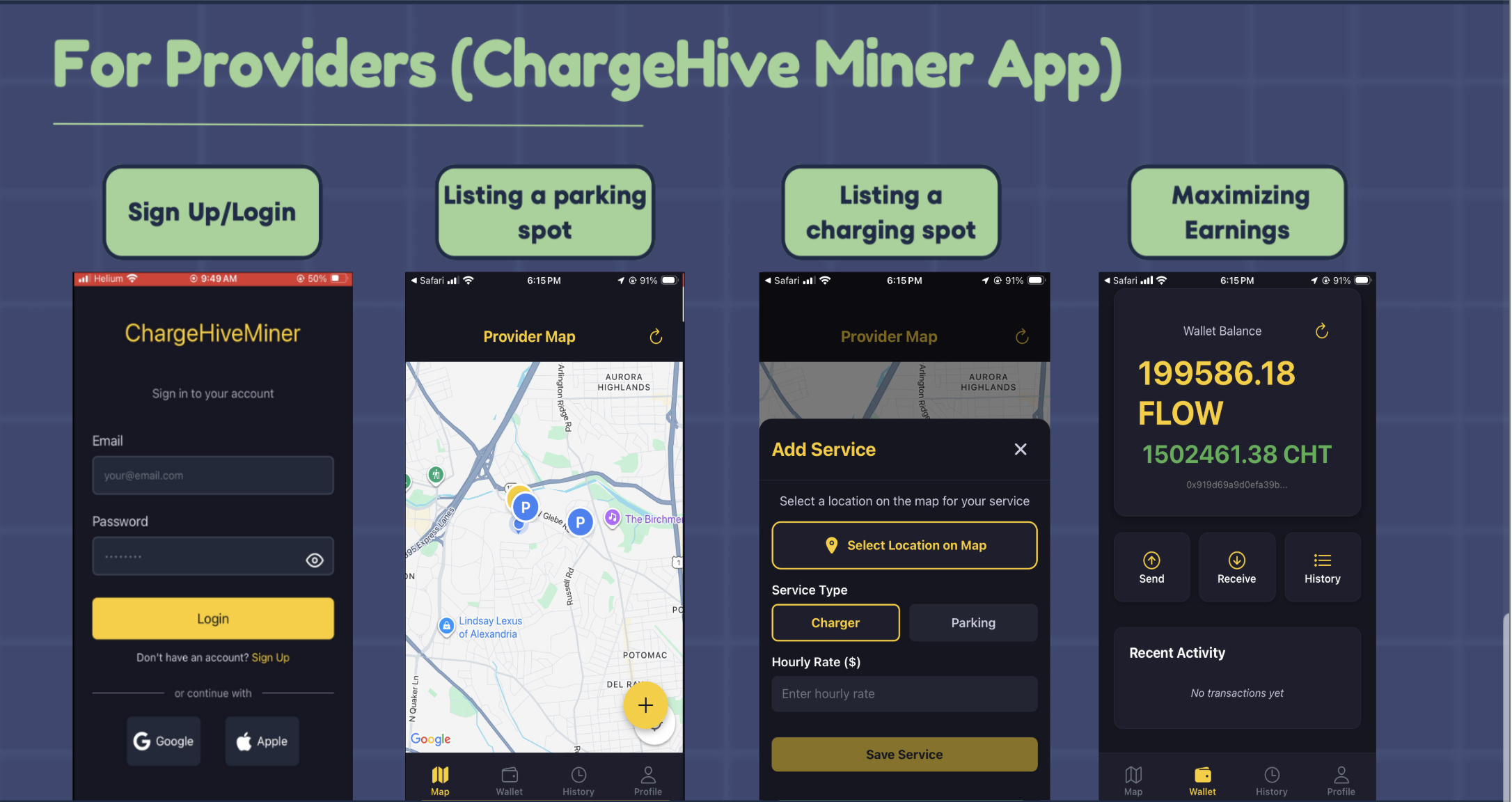ChargeHive is a decentralized peer-to-peer (P2P) network that connects individuals with home EV chargers or parking spaces to nearby EV drivers seeking charging or parking access. Built on the Flow
CHARGEHIVE
ChargeHive is a decentralized peer-to-peer (P2P) platform built on the Flow blockchain that connects EV owners with home charging and parking infrastructure. Users can book charging or parking spots, while providers can rent out their resources and earn rewards. The system integrates DePIN (Decentralized Physical Infrastructure Network) devices to accurately measure energy usage and distribute rewards in ChargeHive tokens (CHT) to both users and providers.
ChargeHive consists of three main components:
1. ChargeHive Backend – implements business logic and smart contract interactions.
2. ChargeHive-User App – allows EV drivers to book chargers and parking spots.
3. ChargeHive-Provider App – allows owners to rent out chargers and parking spots.
Backend Architecture
The backend serves as the core logic layer, managing:
- User and provider profiles, session management, and booking/payment processing.
- Registration of DePIN devices, each with a unique Decentralized Identifier (DID), which maps devices to providers.
Smart Contracts handle:
You can Find the Cadence(Flow) contracts here - https://github.com/Charge-Hive/Chargehive-backend/tree/main/src/cadenceContracts
- Charging and parking session recording.
- Flow token-based payments.
- Reward calculations based on energy dispensed, tracked by the DePIN device (adapter).
- Chargehive Token distribution to both users and providers automatically.
DePIN Device(Charger Plug & Adapter)
The DePIN device is a custom IoT component that sits between the charger and the car:
- Monitors energy flow using a potentiometer.
- Computes rewards according to energy consumption.
- Executes smart contract code on Flow (prototype uses Raspberry Pi).
Prototype Demo:
- A phone simulates the car.
- A home plug simulates the charger.
- The Raspberry Pi-based DePIN device acts as the adapter, logs energy usage, calculates rewards, and updates the Flow contract.
Each adapter has:
- AdapterID – unique identifier.
- Owner Flow Address – links charger and car owner to rewards.
- Real-time reward calculation – updates the Flow smart contract automatically.
Provider App Flow
1. Provider purchases a DePIN device.
2. Registers the device on the Flow blockchain → assigns a unique DID.
3. Device is linked to provider’s Flow address for token rewards.
4. Provider lists the charger or parking spot in the ChargeHive-Provider App.
5. Users can see the listed devices and book them.
6. Provider earns ChargeHive tokens whenever a user completes a session.

User App Flow
1. User opens the ChargeHive-User App.
2. Views nearby chargers or parking spots on a map interface.
3. Selects a charger/parking spot, books it, and pays using Flow tokens.
4. Uses the booked spot at the scheduled time.
5. Rewards in ChargeHive tokens (CHT) are distributed to both user and provider via the smart contract.

Adapter DePIN flow
1. Adapter (DePIN device) connects between charger and car.
2. Reads energy flow from charger to car.
3. Calculates real time rewards for both provider and user.
4. Updates the Flow blockchain contract with usage and reward data.
5. Each adapter is uniquely identifiable via AdapterID and associated DID.
Smart Contract
The Flow smart contract is the backbone of ChargeHive:
- Maintains registry of providers, users, and adapters.
- Records charging and parking sessions.
- Calculates token rewards based on energy usage reported by adapters.
- Automates token distribution to both parties.
- Ensures transparent, immutable, and decentralized logging of all interactions.
ChargeHive Token (CHT)– Utilities & Tokenomics
- Total Supply: 1,000,000,000 (1B) CHT
- Purpose: Incentivize both providers and users, driving network growth and participation.
- Providers (renters): Higher percentage of rewards for sharing chargers and parking spots.
- Users: Smaller percentage of rewards for booking and using chargers.
- Encourages more resource sharing while keeping users engaged.
- Increased rewards for deploying chargers in high-demand areas.
- Introduces a gamification layer, motivating network expansion where it’s most needed.
Future Utilities
1. Merchandise & Services: Spend CHT to buy ChargeHive merchandise, DePIN devices, or charger services.
2. Payment Method: Future versions may allow users to pay for charging/parking sessions directly using CHT.
3. Network Growth Incentive: Holding CHT could enable access to premium features, early access to new chargers, or loyalty programs.
Summary
ChargeHive integrates DePIN infrastructure, Flow blockchain smart contracts, and user-friendly mobile apps to create a token-incentivized P2P network for EV charging and parking. It allows providers to monetize their home chargers, users to conveniently access chargers or parking spots, and both parties to earn rewards transparently through blockchain automation. The system is designed to grow sustainably, with gamified incentives and versatile ChargeHive token utilities.